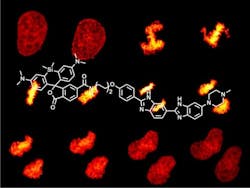Newly developed far-red DNA stain can image living cells
Scientists at École Polytechnique Fédérale de Lausanne (EPFL; Switzerland) have developed a new DNA stain that can be used to safely image live mammalian cells for days, even under demanding imaging conditions.
Fluorescent stains that light up a cell's DNA are popular in live-cell imaging, as they enable tracking key biological processes such as cell division. However, current DNA stains are themselves toxic or require types of light (e.g., blue) that can damage the cells. Ideally, a safe DNA fluorescent stain would be activated in the safer far-red spectrum of light.
Also, many DNA stains are not compatible with super-resolution microscopy, which can capture images of cells at higher resolution than that allowed by regular microscopes. So, the bioimaging community has been waiting for a DNA stain that shows low toxicity, works with far-red light, and can be used in super-resolution microscopy.
The lab of Kai Johnsson at EPFL has now developed a DNA stain that combines two molecules. The first is a fluorescent molecule (silicon rhodamine or SiR) that works in the far-red spectrum and was previously developed in Johnsson's lab. The second one is a well-known DNA stain Hoechst (the chemical name is bisbenzimide). As a result, the team named the new DNA stain "SiR-Hoechst".
The new stain works by binding to a part of the DNA helix known as the "minor groove". Once bound, it turns on and emits a bright fluorescent red light. This is a tremendous advantage, as the stain produces very little noise—if it has not found its target, it stays "off". More importantly, SiR-Hoechst can bind to DNA without affecting its biological function in the cell. And because all cells possess DNA, the probe can be used across numerous species, types of cells, and tissues.
Because SiR-Hoechst works with far-red light, there is little risk of damage to cells. In addition, the light that it emits can be easily distinguished from any background fluorescence of living cells. Unlike other DNA stains, it can safely maintain high-quality staining in live cells for over 24 hours, allowing biologists to identify individual cells in tissue or culture, or track delicate processes, such as cell division, in real time. What's more, the stain can be used in live-cell super-resolution microscopy, paving the way for DNA imaging in cells and biological tissues with exquisite resolution.
The team is now preparing to commercialize SiR-Hoechst through their EPFL startup company, Spirochrome. The company has been in business for a while, supplying the scientific community with a new class of fluorescent probes that can image of the cytoskeleton in living cells with unprecedented resolution.
Full details of the work appear in the journal Nature Communications; for more information, please visit http://dx.doi.org/10.1038/ncomms9497.
Follow us on Twitter, 'like' us on Facebook, connect with us on Google+, and join our group on LinkedIn

